Configure ACLs For a Data Definition
- Right-click on the required Data Definition in the tree view and select Control Access to this Data Definition.
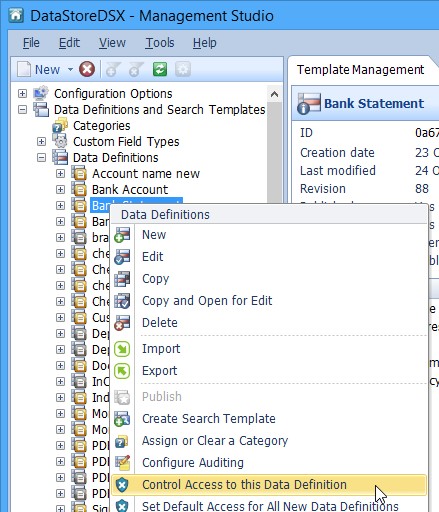
- Click Add and Remove Members.

- Select the User(s), Group(s) or Role(s) you want to allow access to the Data Definition and click Add Member.
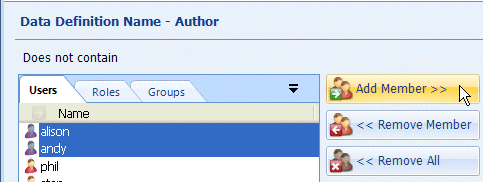
Note: Adding individual users to each Data Definition's Access Control List and configuring their permissions can be time consuming. However, by creating a Group and adding the users to the Group, granting access to the Data Definitions can become much simpler. In this case, you would simply configure access to the Group instead of the individual members of the Group.
Categories can be used to give the same access to all Data Definitions assigned to that Category. See “Configure Data Definition Categories” for more information.
- The selected members are displayed in the Contains the following list. Click Confirm to close the Add New Members window.
- For each User/Group/Role, select whether the member can perform any of the listed operations.
- To change all of the Allow/Deny permissions, click either the Allow All or Deny All button.
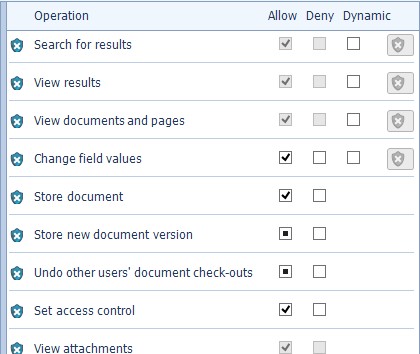
- Search for results – select Allow to enable the member to use the associated Search Template to search for results. Select Deny to prevent the member from using the associated Search Template to search for results. In this example, select Allow.
- View results – select Allow to enable the member to use the associated Search Template to search for and view, results. Select Deny to prevent the member from using the associated Search Template to view search results. Select Dynamic to allow access depending on the set of configured criteria. In this example, select Allow.
Note: View results can only be set to Allow or to Dynamic when Search for results has been set to Allow or to Dynamic.
- View documents and pages – select Allow to enable the member to use the associated Search Template to search for and view, results. The whole document is viewable, not just the search fields. Select Deny to prevent the member from viewing the searched document. Select Dynamic to allow access depending on the set of configured criteria. In this example, select Allow.
Note: View documents and pages can only be set to Allow or to Dynamic when View results has been set to either Allow or Dynamic.
- Change field values – Select Allow to enable the member to use the Modify index values button in Searching Client to change the Index field values of stored documents. See “Modify Index Values” for more information. Select Deny to prevent the member from using the Modify index values button in Searching Client. Select Dynamic to allow the member to modify index values depending on the set of configured criteria.
- Store document – Select Allow to enable the member to use the Data Definition to index and store documents. Select Deny to prevent the member from using the Data Definition to index and store documents. (When set to Deny, the selected Data Definition will not be available for the member in Indexing Studio or Automated Indexing.)
- Store new document version – Select Allow to enable the member to check out a document (which was stored with this Data Definition) from Searching Client, edit it and check it in as a new version. Select Deny to prevent the member checking out a document from Searching Client.
- Undo other users’ document check-outs – When a user checks out a document revision in Searching Client, a document lock is created and no other users can edit the selected document. Setting Undo other users’ document check-outs to Allow enables the selected user to unlock documents which have been Indexed using the selected Data Definition and checked out from Searching Client. Unlocking a document discards all edits made to the document by the Searching Client user. This Access Control is usually assigned to administrators only. See “System Locks” for information on unlocking documents.
- Set access control – Select Allow to enable the member to edit the Access Controls for the selected Data Definition. Select Deny to prevent the member from editing the access controls for the selected Data Definition.
- In addition, if required, you can configure access to attachments. See “Control Access to this Data Definition” for more information about all the available settings.
The user now has access permission to search for all data which has been stored using the selected Data Definition and can view all of the documents which are returned by the search.
Dynamic Access Control Criteria
This window enables you to configure access when an index field contains a specified value.
- Click Add Criteria to add a single criterion. In this example, if the postcode is SL1 6BB, only the postcode is displayed. If the postcode is any other value, the user can view the document. Select postcode from the drop-down list and enter SL1 6BB as the value. Click Add Criteria again to add another criterion, if required.
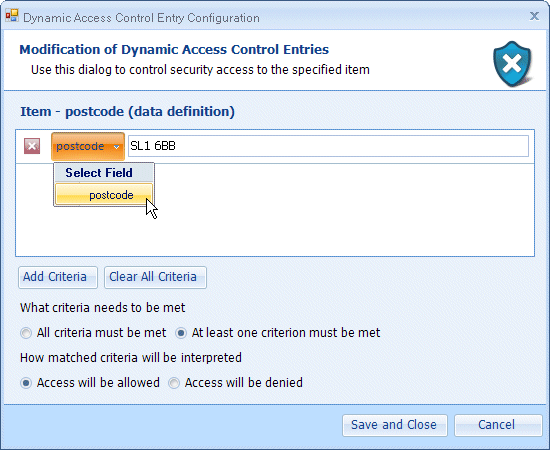
- Decide whether All criteria must be met or At least one criterion must be met. In this example, there is just one criterion, so it doesn’t matter whether you choose All criteria must be met or At least one criterion must be met.
- Decide whether Access will be allowed or Access will be denied. In this example, if the postcode matches SL1 6BB, Access will be denied.
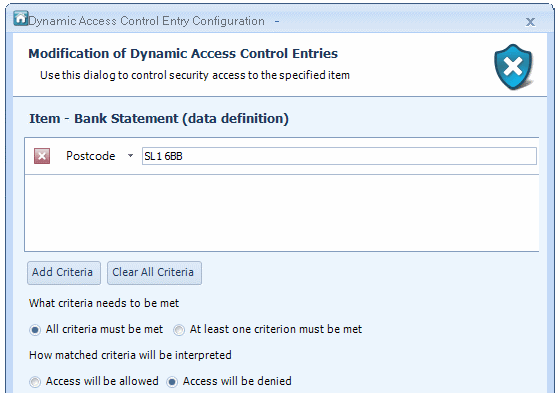
- Click Save and Close to exit the Dynamic Access Control window. Configure Access Control for other users, Groups and Roles, as required. Click Save and Close to exit the Access Control window.

